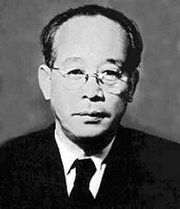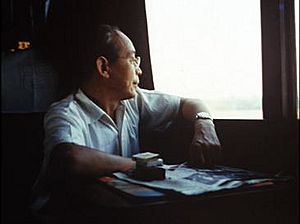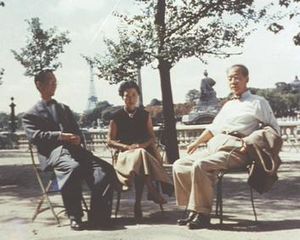Kenji Mizoguchi facts for kids
Quick facts for kids
Kenji Mizoguchi
|
|
|---|---|
 |
|
| Born | 16 May 1898 Hongō, Tokyo, Japan
|
| Died | 24 August 1956 (aged 58) Kyoto, Japan
|
| Nationality | Japanese |
| Occupation | Film director, screenwriter |
| Years active | 1923–1956 |
|
Notable work
|
|
Kenji Mizoguchi (溝口 健二, Mizoguchi Kenji, 16 May 1898 – 24 August 1956) was a famous Japanese filmmaker. He directed about 100 movies between 1923 and 1956.
Some of his most well-known films include The Story of the Last Chrysanthemums (1939), The Life of Oharu (1952), Ugetsu (1953), and Sansho the Bailiff (1954). The last three movies even won awards at the Venice International Film Festival.
A common idea in his films was how women were treated unfairly in Japan, both in the past and in his own time. Kenji Mizoguchi is considered one of the most important directors from the "golden age" of Japanese cinema, along with Akira Kurosawa and Yasujirō Ozu.
Contents
Biography
Early Life and Challenges
Kenji Mizoguchi was born in Hongō, Tokyo, Japan. He was the second of three children. His father was a roofing carpenter. His family was not wealthy. Things got harder when his father's business failed during the Russo-Japanese War.
The family had to move to a different part of Tokyo. Kenji's older sister, Suzu, was adopted by another family. This meant she had to work as a geisha to help support her family.
In 1911, Kenji's parents could no longer afford his school fees. He went to live with an uncle in Morioka for a year to finish primary school. When he returned, he became very sick with rheumatoid arthritis. This illness affected how he walked for the rest of his life.
In 1913, his sister Suzu helped him get a job. He became an apprentice designer for a company that made yukata, a type of Japanese clothing. After his mother passed away in 1915, Suzu took both her younger brothers into her home.
Kenji then studied Western painting at an art school in Tokyo. He also became very interested in opera. He even helped design and build sets for plays at the Royal Theatre.
Starting in Film
In 1917, his sister helped him find another job. He worked as an advertisement designer for a newspaper in Kobe. Many people have noticed that Kenji's early life was similar to the stories in Japanese dramas called shinpa. These plays often showed how geisha made sacrifices for the young men they cared about.
Because of his own family experiences, the topic of women's struggles was very important in all his movies. The idea of a sister sacrificing for her brother appears in many of his best films, like Sansho the Bailiff (1954).
After less than a year in Kobe, Kenji returned to Tokyo. In 1920, he started working in the film industry. He became an assistant director at the Nikkatsu studios. Three years later, he directed his first movie, Ai ni yomigaeru hi (The Resurrection of Love).
Developing His Film Style
After a big earthquake in Tokyo in 1923, Mizoguchi moved to Nikkatsu's studios in Kyoto. His early films included remakes of German movies and adaptations of famous books. While in Kyoto, he learned about traditional Japanese theatre like kabuki and noh. He also studied Japanese dance and music.
His 1926 film, Passion of a Woman Teacher, was shown in France and Germany. It received good reviews, but like most of his early films, it is now lost. By the end of the 1920s, Mizoguchi directed several "tendency films." These movies often showed ideas about social change and politics.
In 1932, Mizoguchi left Nikkatsu and worked for different film companies. His films The Water Magician (1933) and Orizuru Osen (1935) were dramas about women who sacrificed themselves. They helped poor young men get an education. These films showed his growing interest in women's issues. They also featured his unique camera style, using long, continuous shots. This style became his trademark.
His films Osaka Elegy and Sisters of the Gion, both made in 1936, are seen as his early masterpieces. These movies were about young women in modern Japan who rebelled against their surroundings. Mizoguchi himself said these two films showed his artistic growth. Osaka Elegy was also his first full sound film. It marked the start of his long partnership with screenwriter Yoshikata Yoda.
In 1939, Mizoguchi became the president of the Directors Guild of Japan. That year, he released The Story of the Last Chrysanthemums. Many critics believe this is his best film from before World War II. In this movie, a young woman helps her partner become a great kabuki actor, even though it harms her own health.
World War II and Beyond
During World War II, Kenji Mizoguchi made several films that supported the war effort. The most famous of these was The 47 Ronin (1941–42). This was a big historical drama about samurai. Some historians believe he was forced to make these films. Others think he chose to make them.
After the war, Mizoguchi directed many films about women's struggles and their fight for freedom. These films were often set in the Meiji era (a historical period) or in his own time. All of them were written or co-written by Yoshikata Yoda. They often starred Kinuyo Tanaka, who was his main actress until 1954. They had a disagreement when Mizoguchi tried to stop her from directing her own first film.
Utamaro and His Five Women (1946) was a special historical film made during the Occupation. Most historical films were not allowed then because they were seen as too nationalistic. Flame of My Love (1949) is another important film from this time. It shows a young teacher who leaves her traditional life to fight for women's rights. However, she finds that her partner, who seemed modern, still believes men are superior.
International Success
Mizoguchi returned to making films set in feudal times with The Life of Oharu (1952), Ugetsu (1953), and Sansho the Bailiff (1954). These films brought him international fame. Critics like Jean-Luc Godard loved his work. These movies also won awards at the Venice Film Festival.
The Life of Oharu tells the story of a woman who loses her high social standing in the Edo era. Ugetsu and Sansho the Bailiff show the harsh effects of war and violence on families and small towns. Between these three films, he directed A Geisha (1953). He then made two historical films in color: Tales of the Taira Clan and Princess Yang Kwei Fei, both in 1955.
Kenji Mizoguchi passed away from leukemia at age 58 in Kyoto. He was working on a script called An Osaka Story when he died. This film was later completed by Kōzaburō Yoshimura.
Legacy
Kenji Mizoguchi's films are still highly respected today. In 1975, Kaneto Shindō, who had worked with Mizoguchi, made a documentary about him called Kenji Mizoguchi: The Life of a Film Director. Shindō also wrote a book about him.
Mizoguchi's films often appear on lists of the "best films" ever made. For example, Ugetsu and Sansho the Bailiff were on Sight & Sound's "The 100 Greatest Films of All Time" list. The Life of Oharu, Ugetsu, and The Crucified Lovers were on Japan's "Kinema Junpo Critics' Top 200" list.
Many famous directors, including Akira Kurosawa, Orson Welles, Martin Scorsese, and Werner Herzog, have admired Mizoguchi's work. Film historian David Thomson said that Mizoguchi was excellent at showing inner feelings through what the camera showed.
See also
 In Spanish: Kenji Mizoguchi para niños
In Spanish: Kenji Mizoguchi para niños



